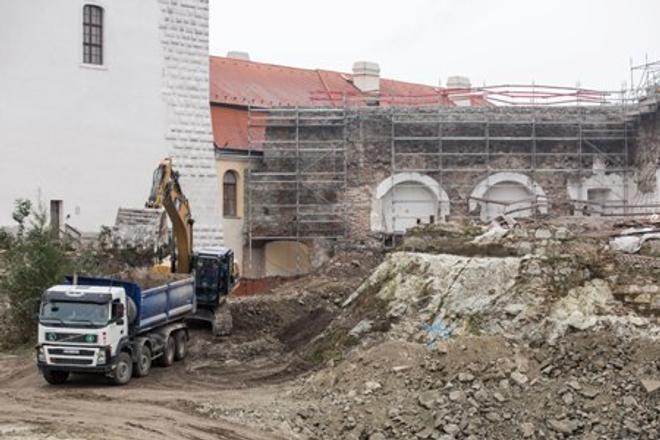THE BRATISLAVA Castle, restored in the second half of the 20th century after lying in burnt ruins for 140 years, needed another extensive reconstruction. This was started in the first decade of the new millennium and included archaeological research.
The research started in 2008, and in 2014 stunning findings were published: under the northern part of the Castle, below the Winter Riding Hall and close to the Baroque garden where an underground car park for 222 cars is planned, ancient monuments from around the 1st century B.C. were found, made by Romans but probably ordered by Celts who lived here at that time.
This development prompted a heated debate and an initiative to stop the construction of the car park by arranging a thorough assessment by an international committee; as well as a debate involving experts, students and an informed public.
On December 3, hundreds of protesters gathered in front of the nearby Slovak parliament building to express their disapproval and to stress the importance of the Celtic-Ro-man monuments. Activist Matej Vagač told the TASR newswire that the goal of the staged protest – as well as that of an open call recently sent to the new Speaker of Parliament Peter Pellegrini and signed by almost 7,000 petitioners – is to launch a debate between builders, politicians, experts and the public striving to find the best solution.
Archaeologist Tatiana Štefanovičová, who worked at the Bratislava Castle in the 1950s to the 1970s, says the findings, which probably date back to the 1st century B.C., are unique not just in central Europe, but maybe in the whole of Europe. She would welcome a special committee to evaluate whether the construction plan of the car park is in compliance with Slovakia's cultural and historical interests.
The fears expressed in the open call include those stemming from the potential impact of the construction works on the entire castle hill, the static balance of the tunnel leading under the hill, etc.
Pellegrini said, even before the protest, that the parking lots are meant for the public, for visitors of events and the Castle itself, and not for MPs. However, independent MP Alojz Hlina opposed this, saying that there are many reasonably-priced parking lots nearby, as those planned for the Castle would cost approximately three times more other car parks in the vicinity. Hlina added he would file a motion with the General Prosecutor’s Office over abuse of public finances and damaging archaeological heritage.
Head of the parliamentary office, chancellor Daniel Guspan increased the expenses for the construction, but this was allegedly caused by the presence of a different sort of bedrock than originally thought, and by the changes due to the ancient monuments and the need to preserve them. Initially, the entrance to the car park was moved. Some of the findings will be exhibited for the public, and the rest will buried underground again in order to keep them intact, the SITA newswire wrote.
New Bratislava Mayor Ivo Nesroval plans to meet Pellegrini, as well as officials from the City and National Monument board along with experts, to debate the situation and the solutions.
Historian and Old Town borough councillor Štefan Holčík argued for the Bratislavské Noviny, a local newspaper, that the archaeological research was duly done and the design was duly changed, cutting the originally planned capacity of parking places and increasing the costs for preserving the findings. He insists that all findings are well secured against damage, and that the best way to keep them for future generations is to bury them underground again – especially for foundations of a wall never before seen by the public – which is the case of an ancient wall, about 16 metres long. Future generations will also be grateful for the parking space, he added.
The open call claims that the unique findings are exceptional in central Europe, even older than the nearby Roman complex Carnuntum in Austria. The findings include walls that are more than 2000 years old, fragments of decorated tiles, a compact cast floor, interior stucco, precious gold and silver Celtic and Roman coins, and more. They are so important and rare that Slovak archaeologists were included in the European project Danube Limes Brand, according to Bratislavský Kuriér local newspaper. Archaeologists concluded that the whole issue could also have a positive side if it opened a wider debate on the findings and how best to handle them, instead of keeping the results hidden from experts and the public.
Štefanovičová said, as quoted by the Plus Sedem Dní weekly, that her Austrian colleagues asked her if there is no better place in Bratislava for an underground car park than at a historical monument.



 Building parking lot at the Bratislava Castle. (source: SITA)
Building parking lot at the Bratislava Castle. (source: SITA)